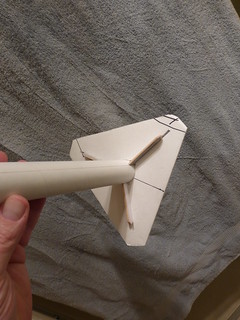As many have suggested most important at those ages is to get the birds in the air. RTF and ARTF models are outstanding for first models.
Once they have had a few flights and are excited about building their own models then a Starter model Like the Alpha-III with a plastic fin can can be a very good "technique" teaching tool.
One of the most important leasons you can give your kids is teaching them to following the instructions. The most important Technique for Beginning Rocketeers: is teaching them the
double Glue Joint method for using Elmers White or Yellow glues for most Low Power construction applications.
While this method is not directly shown in most model instructions, it is covered in G. Harry Stines "HandBook of Model Rocketry".
To start apply a line of glue covering the entire part to be jointed with white or yellow glue. Not alot just enough to be worked into the grain or cardboard parts. Both sides to be joined. ie if a fin to body joint: apply to the root edge of the fin then press onto the body tube alignment line and immediately remove and set aside to dry. If an engine block or centering ring apply glue with the finger completely around the part and set aside to dry. when these parts are try to the touch apply a second light coating of the same glue to the root edge and with the finger to then inside of the body tube approximately where the engine block or centering ring will be set. apply the fin to the body tube or slide the motor mount into the body tube glue in one swift forward slightly twisting motion. Note that the second application of glue re-activates the first and will sieze pretty quickly. Once this joint has as a few minutes to dry the joint will be stronger then both materials being joined. Further this method will out last CA application by decades. White or Yellow glues do tend to shrink a bit during drying but should not be a major factor in finsihing. Double glue joint construction will add a bit less mass to the model then using epoxy for motor mount fastening but as I mentioned must be done in a slightly twisting forward non-stop motion do avoid siezing in the wrong location.
It is without doubt the most important construction method to teach Brand New Rocketeers Hands down second only to the model rocket safety code

Hope this helps.





